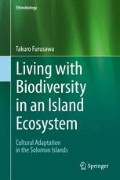Abstract
This chapter explores the psychological aspects of human–environmental/ecological interaction. The people of Roviana identified and acknowledged a variety of interactions that occur between humans, plants, and animals. They recognized the ecological fact that animals often affect humans through their relationships with plants, and these people recognized themselves as a part of the local ecological chains and food webs. However, this chapter also shows how the villagers recognized that people may have adverse effects on the ecosystem. For example, villagers reported their negative effects for plants they recognized as having direct negative effects on humans or, more simply, included plants they found problematic and typically killed. These analyses are used to discuss the existence of traditional conservation ethics that are designed to protect biodiversity and may affect it. In some ways, the people of Roviana are similar to people in Western countries, with an interest in short-term gains at the expense of the environment in some cases, while the conservation ethics of conservation organizations are often stronger than those of some individuals in both Roviana and in the West.
Access this chapter
Tax calculation will be finalised at checkout
Purchases are for personal use only
Notes
- 1.
All individual s agreed to participate in this research after the author disclosed the methods and goals of the study.
- 2.
In the actual analyses, cluster analysis was used to classify animals; impacts of plants and animals were used as variables for measuring the Euclidian distance, and the Ward method was used for clustering.
References
Atran S, Medin D, Ross N, Lynch E, Coley J, Ek’ EU, Vapnarsky V (1999) Folkecology and commons management in the Maya Lowlands. Proceedings of the National Academy of Sciences of the United States of America 96(13):7598–7603
Atran S, Medin D, Ross N, Lynch E, Vapnarsky V, Ek’ EU, Coley J, Timura C, Baran M (2002) Folkecology, cultural epidemiology, and the spirit of the commons: a garden experiment in the Maya Lowlands, 1991–2001. Current Anthropology 43(3):421–450
Blaber SJM (1991) A checklist and notes on the current status of the birds of New Georgia, Western Province, Solomon Islands. Emu 90(4):205–214
Doughty C, Day N, Plant A (1999) Birds of the Solomons, Vanuatu & New Caledonia. A & C Black, London
Medin DL, Atran S (eds) (1999) Folkbiology. MIT Press, Cambridge
Pikacha PG (2008) Wild west: rainforests of Western Solomon Islands. Melanesian Geo Publication, Honiara
Rappaport RA (1984) Pigs for the ancestors: ritual in the ecology of a New Guinea People. Yale University Press, New Haven
Author information
Authors and Affiliations
Rights and permissions
Copyright information
© 2016 Springer Science+Business Media Singapore
About this chapter
Cite this chapter
Furusawa, T. (2016). Recognized Webs in Ecosystems. In: Living with Biodiversity in an Island Ecosystem. Ethnobiology. Springer, Singapore. https://doi.org/10.1007/978-981-287-904-2_6
Download citation
DOI: https://doi.org/10.1007/978-981-287-904-2_6
Published:
Publisher Name: Springer, Singapore
Print ISBN: 978-981-287-902-8
Online ISBN: 978-981-287-904-2
eBook Packages: Biomedical and Life SciencesBiomedical and Life Sciences (R0)

